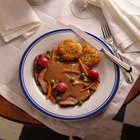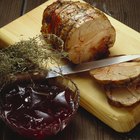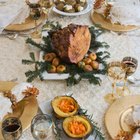margouillatphotos/iStock/GettyImages
The rolled rib roast is a cut of meat from between the shoulders and behind the ribs. Once the bones are removed, the roast is rolled and tied in a cylinder-like shape, which allows the heat to penetrate the meat in an even form. Searing the roast in a hot oven for about 15 minutes and then turning the temperature down for the remainder of the cooking time achieves a tantalizing brown crust on the outside and tender, juicy meat on the inside. Stick to the 20 to 30 minute per pound rule for the meat to be a perfect medium-rare.
Set the roast out on the counter until it reaches room temperature, about two hours for a 3- to 4-pound rolled roast. This is not a safety concern, because bacterial growth doesn't begin until about four hours.
Unwrap the roast and place it on a clean work surface. Rub the outside of the roast with seasonings such as salt and pepper, or insert small garlic cloves into the surface of the roast by making incisions with the tip of a sharp knife. Herbs can impart complex flavors during cooking. Tuck a small bay leaf under the twine in two or three places on the roast, or rub dried, crumbled herbs such as rosemary, sage, thyme or savory over the outside of the meat.
Preheat the oven to 400 degrees Fahrenheit. If your oven is equipped with a convection fan, turn it on. Place the roast on a rack in the bottom of the roasting pan with the fat side of the meat facing up.
Place the roast in the center of the oven. Sear the roast in the hot oven for about 15 minutes, or until a caramelized layer develops. The lightly browned outer layer creates the flavor-packed bits that make the drippings so good. While it is not required, a convection fan circulates the hot air in the oven and helps the outer, caramelized crust develop.
Turn down the oven temperature to about 250 F and continue to cook the meat uncovered and with the convection fan off. The cooking time is generally about 20 to 30 minutes per pound, or about two hours for a 4-pound roast. Baste as necessary to redistribute the flavorful drippings. Basting about every 30 minutes helps maintain an evenly brown and juicy roast. Check the temperature in the center of the roast using an instant-read meat thermometer for accuracy. Remove the roast from the oven when the internal temperature is 125 F. Set the roast where it can rest undisturbed.
Cover the resting meat with a loose tent of aluminum foil, if desired. Rest the meat until the temperature increases to no more than 130 F for medium-rare, pink-in-the-middle slices. Generally, the resting time is about five minutes for each pound of meat. Slice the roast and transfer the meat to a serving platter.
Related Articles

How to Prepare Chuck Tender Roast

How to Cook a Beef-Pork Combo Roast

How to Cook Tender Rolled Flank Steaks ...

How to Cook a Bottom Round Roast on a ...

How to Cook an 8- to 10-Pound Beef ...
How to Cook Roast Beef in a Cast-Iron ...

How to Make a Blackbuck Antelope Roast

How to Slow Cook an Eye of Round Roast ...

How to Cook a 15-Pound Rib Roast

How to Cook a Prime Rib That Melts in ...

How to Turn a Chuck Roast Into Steak
How to Cook a Choice Chuck Roast

How to Slow Cook a Rolled Rib of Beef

What Does It Mean to Score Roast Pork?

How to Carve a Bone-In Ribeye

How to Roast an Eye Round Roast at High ...

How to Cook a Rolled Beef Chuck Roast ...

How to Barbeque Boneless Prime Rib on a ...

Shank Ham Cooking Directions
How to Cook a Spencer Roast
References
Resources
Tips
- Cook a rolled roast with or without the traditional vegetables. If you include vegetables, baste them with drippings when you baste the roast. Monitor the level of the drippings in the pan and add broth if necessary.
Warnings
- The U.S. Department of Agriculture recommends cooking meat to an internal temperature of 145 F.
Writer Bio
Fern Fischer's print and online work has appeared in publications such as Midwest Gardening, Dolls, Workbasket, Quilts for Today and Cooking Fresh. With a broader focus on organic gardening, health, rural lifestyle, home and family articles, she specializes in topics involving antique and modern quilting, sewing and needlework techniques.